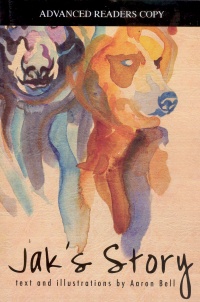| ________________
CM . . .
. Volume XVI Number 36. . . .May 21, 2010
excerpt:
The story begins with Jak, a 12-year-old boy, being chased by a bully through a ravine. The ravine is where Jak feels at home, but it is going to be destroyed for a housing development. Even though Jak is a quiet boy, he develops leadership skills as he creates a plan to save the habitat of so many animals. Jak receives guidance and wisdom from the teachings of Grandfather Rock, a talking boulder, who gives him insight into how to deal with the bully and how to save the ravine. The cover art is a watercolour of a bear and a fox - the bear is exquisite, but the fox looks like a very large and heavyset dog. In the story as told by Grandfather Rock, the bear is a narcissistic creature that is tricked by a fox. Jak identifies with the fox, an underdog needing to use his wits to win over large foes. Inside the book, the black-and-white cartoons do not match the gravity or style of the First Nations content. The book has a number of strengths:
The book’s weaknesses include problems of believability:
Jak’s Story is enjoyable and interesting, but it suffers from a bit of an identity crisis. Is the audience 6 to 8-year-olds (justifying the oversimplicity of the protest plot and short book length) or is it teenagers (focus on activism, developing leadership skills and romance)? Is the novel art (wisdom of the elders) or a comedy (the cartoon illustrations)? The author has talent and lots of potential, and so I expect great work from him in the future. Recommended with reservations. Shelbey Krahn is a librarian for the School of Education at Laurentian University in Sudbury, ON.
To comment
on this title or this review, send mail to cm@umanitoba.ca.
Copyright © the Manitoba Library Association. Reproduction for personal
use is permitted only if this copyright notice is maintained. Any
other reproduction is prohibited without permission.
NEXT REVIEW |
TABLE OF CONTENTS FOR THIS ISSUE
- May 21, 2010.
AUTHORS |
TITLES |
MEDIA REVIEWS |
PROFILES |
BACK ISSUES |
SEARCH |
CMARCHIVE |
HOME |
